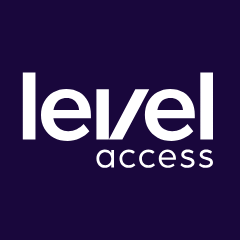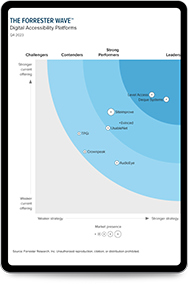7 Questions to Ask During ADA Compliance Testing
Mar 13, 2020
According to The World Bank, 15% of the world’s population experiences some form of disability. Is your website able to serve this significant portion of the population?
Unfortunately, countless websites exist that cannot be read or used by members of the world’s largest minority, individuals with disabilities. According to the National Business & Disability Council at The Viscardi Center in Albertson, New York, at least 90 percent of government and e-commerce websites in the U.S. alone have barriers that prevent people with disabilities from using them.
This is despite the fact that barrier-free websites are fully achievable with the right expertise, including accessibility audits and ADA compliant website tests.
According to Pew Research, half of Americans with disabilities are using the Internet on a daily basis. When a person with a disability encounters a website that isn’t accessible, these barriers can have a negative impact on their online experience. For example, if the person is blind, their screen-reading software won’t be able to interpret any images that haven’t had text alternatives added to them. If the person has a physical disability and is using something other than a mouse to control their computer, they won’t be able to switch between fields if the content is not coded in a logical order.
A website that passes ADA compliant website tests, on the other hand, has these and other barriers removed. It meets specific technical requirements that ensure a website will be accessible to a wide range of people with various kinds of disabilities. However, not all organizations are exceedingly familiar with these technical requirements.
This is why a wide variety of ADA compliance testing tools exist that claim to check whether your website is ADA-compliant. These are automated, as they test for the presence or absence of specific features, and typically display the results or automatically generate a report for you.
You certainly can’t use every method of ADA compliance testing, so how do you choose the right one? And how do you know you can rely on it? Here are seven questions to help you choose the right ADA compliant website test.
1. Is ADA website compliance testing recommended by an independent firm?
A company that makes money from the sales of a particular ADA compliant website tool is going to promote it over other options. Look for independent experts or firms that have listed the evaluation tools they consider to be useful, or have written positive reviews, without something to gain from endorsing particular products.
2. Was it developed by a reliable organization?
Who’s behind the testing software? Has the ADA compliant website testing tool been developed by a reputable group or consortium in the industry? Or is it from an unknown company that’s more concerned with profit than purpose?
3. Is it on the W3C Web Accessibility Evaluation Tools list?
The World Wide Web Consortium (W3C) maintains a list of Web Accessibility Evaluations Tools. It includes almost 100 different kinds of website audit and ADA compliance testing tools, and is often a good place to start. The tools are searchable by type of tool, accessibility guidelines it tests against, etc.
4. What standards or guidelines does it use?
There are all kinds of accessibility guidelines out there, from Section 508 requirements to the Irish National IT Accessibility Guidelines. If you specifically want to test whether your website is ADA compliant, the testing tools you use should be referring to the technical requirements of the Web Content Accessibility Guidelines (WCAG), which are the universally accepted technical standards for online accessibility.
5. Does it test for various levels of WCAG 2.1 conformance? What about WCAG 2.2?
WCAG includes three levels of accessibility conformance, from minimum to highest: A, AA and AAA. Level AA is usually the target level, since it’s more serviceable than level A, and not as difficult to achieve as level AAA. The ADA compliant website test you choose should make distinctions between these three levels.
WCAG 2.2 is a newer, updated set of standards, which builds upon the requirements of WCAG 2.0. It’s ideal for an ADA-compliant website test to evaluate against the more recent WCAG 2.2 standards.
6. Does it check for multiple types of barriers?
Some ADA compliance testing tools look for many different kinds of accessibility problems. Others only check for one type of barrier, such as use of color. If you want to know whether your website is ADA compliant, testing just one or two features is an incomplete evaluation .
7. What kind of report does it produce?
Every ADA compliance testing tool will generate a report when you run it, but some reports will be more useful to you than others. How detailed is the report? Do you have the option to choose different kinds of reports, depending on your needs? Does it provide step-by-step, code-level examples of how the accessibility problems can be solved? And can you understand the report, or is it filled with too much jargon?
Beware of limitations
Although ADA compliant website tests are helpful, it’s important to remember that automated testing has its limitations. It is widely accepted within the accessibility industry that automated ADA compliance testing only identifies 25 — 30% of WCAG technical requirements. It may also give false positives and false negatives. Plus, there are many additional areas of a website to check that require human judgment — an automated test won’t be applicable for these areas.
The most effective automated ADA website compliance test can certainly be useful. It can give you a sense of how accessible your website is for customers with disabilities, and what kinds of barriers might be preventing them from being able to browse or fill out forms, for example. But in order to be confident your website is in full compliance with the ADA, it’s best to have a thorough accessibility audit or evaluation done by experts, including individuals with disabilities. They will perform a variety of checks, not just automated ADA compliance testing.
An innovative solution
Level Access combines the efficiencies of automated testing with an expert, manual evaluation. If you’re Interested in learning how Level Access can help, connect with us today.
Subscribe for updates


